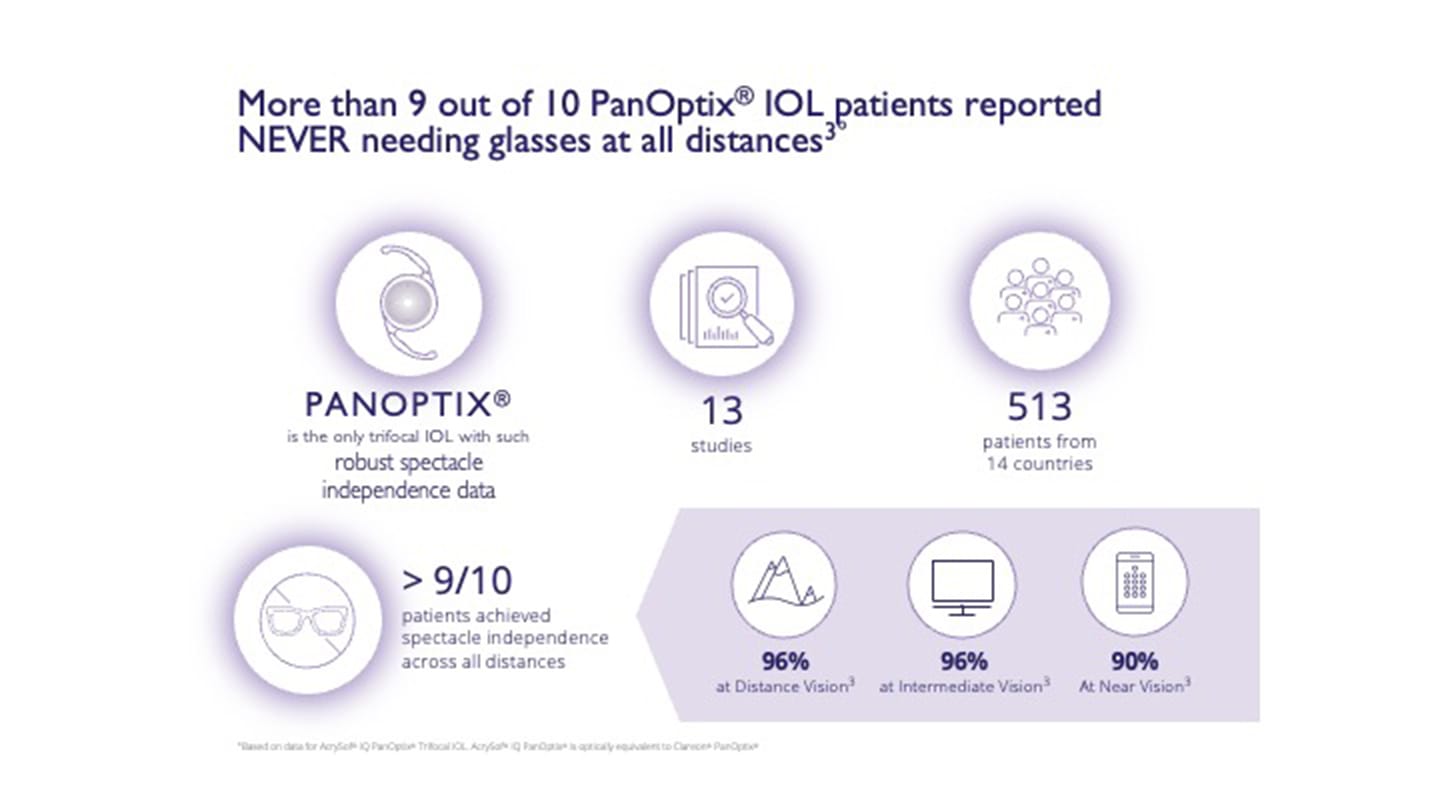Over the past decade, the intraocular lens (IOL) landscape has expanded dramatically. Cataract surgeons today can choose from a wide range of presbyopia-correcting IOLs (PCIOL), each with unique optical designs, materials, and patient lifestyle goals. This progress improves patient care but also poses a challenge: how can surgeons identify the lens that best balances visual performance with satisfaction?
This question has grown even more relevant as new professional frameworks emerge to help classify and evaluate IOLs. At the 2025 European Society of Cataract and Refractive Surgeons (ESCRS) meeting, the Functional Vision Working Group introduced an evidence-based classification system for simultaneousvision IOLs. This system organizes lenses by their range of field (RoF), using visual acuity outcomes across the defocus curve to define categories such as Partial RoF Enhance, Partial RoF Extend, and Full RoF Continuous (1).

Within this framework, Clareon® PanOptix® was recognized as a “Full Range of Field Continuous” IOL – a distinction reserved for simultaneous vision lenses that deliver continuous vision across distance, intermediate, and near (1).
This recognition underscores PanOptix’s ability to provide patients with consistent clarity at distance, intermediate and near, but it also raises a critical consideration: the ESCRS criteria do not explicitly account for visual disturbances such as glare, halos, and starbursts (1,2*).

We sat down with Dr. Neel Desai (pictured above) and Dr. Andrzej Dmitriew (pictured right) for a discussion on the role these subjective phenomena often play in patient satisfaction – and how they can differ between IOL platforms.‡‡ To better understand how optical design and material composition shape these outcomes, these ECPs explored common myths and emerging evidence, drawing on both laboratory data and real-world clinical experiences.
Debunking Common Myths
Myth #1: Chromatic Aberration is Inconsequential
One common misconception in PCIOL selection is that chromatic aberration has little to no impact on visual disturbances. Recent laboratory evidence challenges this belief. A 2024 report from Labuz et al. evaluated trifocal IOLs, including PanOptix and chromatic-aberration–correcting designs such as Synergy and FineVision Triumf. Using a modified C-Quant straylight meter, they measured glare at lower visual angles (3).
According to Dr. Desai, “The results found that chromatic-aberration–correcting models, such as Synergy and FineVision Triumf, do induce higher straylight values. In fact, markedly more than PanOptix” (3).
The results also showed that at angles of 2.5° and 3.5°, PanOptix maintained straylight levels close to those of a young crystalline lens, while at 2.5°, Synergy measured more than four times higher (3).
A subsequent 2025 Apple Labs study confirmed these findings under similar conditions. Because Odyssey shares the same chromatic-aberration–correcting approach as the Synergy^ lens, its optical behavior was evaluated within that same design context. In these laboratory simulations, Clareon PanOptix again showed the lower scatter across tested angles, while Odyssey^ displayed greater variability – particularly at lower angles where patients tend to be most sensitive to glare (4).
Added Dr. Desai, “These findings confirm what we see in clinic: not all diffractive optics are equal. Small design changes can raise straylight. In my experience, lenses like PanOptix that minimize light scatter give patients confidence in all light conditions and result in low complaints of glare and starbursts. With improved patient confidence comes greater surgeon confidence in recommending these lenses” (5-7°).
Dr. Andrzej Dmitriew agrees. “These insights underscore why visual disturbances should not be dismissed as incidental. They reflect how – in addition to other factors, such as dry eye – optical design can directly influence the patient’s day-to-day experience.”
As the discussion continued, the experts’ attention shifted to another factor often overlooked in lens evaluation: the role of edge design in minimizing glare and maximizing usable optic.
Myth #2: IOL Features Outweigh Material Design
Another misconception in PCIOL selection is that advanced optical features alone dictate patient outcomes, while the underlying material design plays only a minor role. In practice, the edge profile, optic quality and refractive index of an IOL can be a fundamental piece of minimizing visual disturbances.
Clareon PanOptix offers a fully usable 6.0 mm optic, compared with 4.9 mm in the Tecnis 1-piece (5,8-11).
“This provides nearly 50% more usable optic area, which may be important for younger patients whose pupils dilate beyond 5 mm in dim light,” said Dr. Dmitriew. “Under these conditions, more of the optic is engaged, potentially reducing risk for edge scatter (8).”
Laboratory studies support these differences. Das et al. (2019) found that IOLs with straight edges and smaller optics were more likely to cause glare under off-axis lighting. Lenses with curved edges and fully usable optics – such as Clareon – can contribute to lower glare (8,10,12).
“With so many features available in today’s IOLs, it’s tempting to minimize the role that material design plays in visual disturbances,” Dr. Desai added. “But in my experience, the true patient value begins with how the material is engineered. The larger optic of the Clareon portfolio helps me feel confident when counseling active patients, who typically expect excellent vision in all lighting conditions.”
Another important material consideration is refractive index, which may determine the height of diffractive steps on the lens surface. In theory, a higher refractive index may allow for lower diffractive step heights, which could help reduce light scatter. Laboratory modeling suggests that differences in refractive index between IOL materials can influence step height design. For example, lenses using a higher index-such as Clareon PanOptix with ENLIGHTEN™ technology-may achieve shallower diffractive profiles compared to lenses using a lower index (13-15 ¶ ^).
Dr. Desai also observed, “Step height is one of those subtleties that surgeons sometimes overlook, but, logically, it could make a real difference. Hypothetically, a smaller step height, like what we see with PanOptix, could mean less scatter. Additionally, with ENLIGHTEN technology we achieve a much more practical focal point at 60cm – which is better for achieving intermediate vision for working on computer screens or driving at night.”

The Importance of Clinical Experiences
While laboratory data provides critical insights into IOL performance, “realworld performance can’t be ignored, either,” shared Dr. Dmitriew. Two recent studies underscore how PanOptix and Odyssey differ when it comes to visual disturbances and patient satisfaction.
The Hiroko Bissen-Miyajima 2025 study evaluated early outcomes of the Odyssey^ in a Japanese population. Visual acuity was strong at distance and intermediate ranges, but 48% of patients (n=50) reported moderate to severe halos one month post-op (16**).
From a larger prospective, a Zhu et al. 2024 meta-analysis of 580 patients across 10 countries between 3-12 months found that while halos were the most common disturbance, fewer than 3% described halos, glare, or starbursts as “very bothersome.” Severe cases occurred in only ~5% of patients, with consistent results across global populations reinforcing the reliability of PanOptix outcomes (17-20***).
Considering Production Standards
Production Standards & Predictability
Beyond optical design, the manufacturing precision of an IOL plays a central role in ensuring consistent refractive outcomes for patients. Even the most advanced lens design can falter in practice if it does not meet rigorous production benchmarks.
Industry standards set limits for spherical and cylindrical accuracy, imaging quality, and modulation transfer function (MTF), ensuring baseline consistency across manufacturers (22).
Clareon goes beyond these requirements, holding itself to stricter tolerances. Internal data show Clareon production standards are tighter than the ISO benchmarks, up to twice as tight for some power ranges, reducing variability across lens batches (23).This translates into predictable refractive outcomes that patients and surgeons can trust.
“Predictability is everything,” Dr. Desai commented. “Surgeons expect not just clear vision but reproducible outcomes – because that’s what patients deserve.”
“Absolutely,” agreed Dr. Dmitriew. “Knowing that Clareon PanOptix is manufactured beyond ISO standards gives me confidence that what I implant today will perform as consistently as it has in the past.”
This emphasis on tight production controls provides a foundation for the refractive accuracy and stability that surgeons can trust.
Evaluating Contrast Sensitivity
In addition to refractive predictability, contrast sensitivity can be an important factor for real-world visual quality (24).
Recent evidence demonstrates that Clareon PanOptix provides measurable improvements over its AcrySof predecessor. In fact, significantly higher scores on the area under the log contrast sensitivity function (AULCSF) were reported for Clareon PanOptix (1.449 vs. 1.358, p = 0.01), (25††).
Tuuminen et al. (2025) reinforced these findings: PanOptix achieved superior photopic (1.47 vs. 1.38) and mesopic (1.16 vs. 1.06) AULCSF scores (p < 0.001) compared with AcrySof IQ PanOptix.23,Ω

“Importantly,” added Dr. Desai, “Clareon showed zero incidence of glistening or subsurface nano-glistening, versus 88% and 26% in the AcrySof group,” added Dr. Desai, a difference potentially likely contributing to its stronger longterm contrast performance (24).”
Contrast sensitivity values for Clareon PanOptix also align closely with those of healthy, phakic patients without cataract. Data presented by Khoramnia demonstrated that PanOptix patients’ contrast sensitivity remained within one standard deviation of age-matched phakic controls, both photopically and mesopically-suggesting a level of vision closer to natural quality (26†).
“Contrast sensitivity can be a hidden factor that drives patient satisfaction,” noted Dr. Dmitriew. Even with good acuity, subtle deficits can make everyday tasks, like reading a menu in a dimly lit restaurant or evening walks, frustrating. With Clareon PanOptix, patients tell me their vision feels crisp and reliable across different lighting conditions.”
“Taken together, these findings underscore that contrast advantage is not merely a laboratory metric but a clinically meaningful outcome,” explained Dr. Desai.
Visual Acuity
At the 2025 ESCRS Congress, Andrzej Dmitriev presented data comparing Odyssey^ and Clareon PanOptix. Both delivered excellent distance and near acuity; PanOptix achieved 0.10 logMAR at 66 cm for intermediate vision, while Odyssey^ measured 0.17 logMAR at the same distance. These findings are based on a preliminary dataset of 10 patients per IOL group, suggesting promising trends, though further studies with larger cohorts are needed to confirm these initial observations (21).
Spectacle Independence
When evaluating PCIOLs, surgeons often focus on an outcome that often matters most to patients: and whether they can remain spectacle-free.
The Hiroko Bissen-Miyajima 2025 study of Odyssey also found that only 64% of patients achieved complete spectacle independence, with over a third still relying on reading glasses for near tasks at one month post-op (16‡).
Additionally, a global meta-analysis of 500 patients across 13 studies and 14 countries at 3-12 month by Zhu et al. (2024) reported that 91.6% of PanOptix patients were completely spectacle independent (27◊).
Dr. Desai observed,“In my practice, quality distance vision and spectacle independence are the outcomes my patients care about most frequently. Given that distance vision sets the foundation for spectacle independence, PanOptix delivers on all fronts-ultimately allowing my patients who want to live a more active lifestyle with freedom from glasses (28).”
In closing, as PCIOL options expand, evaluating both design and material is key to aligning outcomes with patient expectations. Evidence shows Clareon PanOptix and TECNIS^ Odyssey^ both deliver strong acuity, though data on visual disturbances, contrast, and spectacle independence highlight how design and material choices can influence the patient experience.
“Simply put,” noted Dr. Dmitriew, “understanding these nuances supports more confident counseling and optimized results.”
Alcon medical device(s) comply with the current legislation for the medical devices. Please refer to relevant products’ instructions for use for complete list of indications, contraindications and warnings.
^Trademarks property of their respective owners *N=129
**Rate of post-operative halo on a five-point scale (not at all, slight, mild, moderate, and severe) in a patient-reported questionnaire; n = 50 eyes of 25 patients.
***Based in a meta-analysis of 11 unique clinical studies with 580 patients in 10 different countries, including “very bothersome” and “severe” visual disturbances. Clinical studies were performed on the AcrySof IQ PanOptix IOL; AcrySof IQ PanOptix and Clareon PanOptix are optically equivalent. †3 months post-op.
‡Based on patient reported questionnaire in a retrospective review with 50 eyes of 25 patients. One-month post-operative assessment.
†† Contrast sensitivity was significantly better in the Clareon PanOptix group at all degrees, including the area under the log contrast sensitivity function (p = 0.01); 6.3° = 0.019 vs 0.026; 4.0° = 0.02 vs 0.03; 2.5° = 0.026 vs 0.037; 1,6° = 0.045 vs 0.059; 1.0° 0.078 vs 0.105; 0.64° = 0.156 vs 0.201
‡‡ ECPs are Alcon Consultants
°Based on prospective multicenter randomized study at 6 months, significantly more subjects reported not experiencing starburst and glare (p<0.05 n=276).
¶ vs. TECNIS Odyssey† and Synergy ◊Based on data for AcrySof IQ PanOptix Trifocal IOL.
© 2025 Alcon Inc. GLB/IMG-CPO-2500003
References
- Ribeiro F, Dick HB, Kohnen T, et al. Evidence-based functional classification of simultaneous vision intraocular lenses: seeking a global consensus by the ESCRS Functional Vision Working Group. J Cataract Refract Surg. 2024;50(8):794-798. doi:10.1097/j.jcrs.000000000000150.
- Clareon PanOptix Trifocal Hydrophobic Acrylic IOL Model: CNWTT0 2021 Directions for Use.
- Łabuz G, Khoramnia R, Yan W, et al. Characterizing glare effects associated with diffractive optics in presbyopia-correcting intraocular lenses. J Cataract Refract Surg. 2024;50(4):413-419.
- Alcon Data on File, 2025. REF-28161.
- Kohnen T, Lapid-Gortzak R, Ramamurthy D, et al. Clinical Outcomes After Bilateral Implantation of a Diffractive Trifocal Intraocular Lens: A Worldwide Pooled Analysis of Prospective Clinical Investigations. Clin Ophthalmol. 2023;17:155-163. Published 2023 Jan 10. doi:10.2147/OPTH.S377234.
- Alcon data on file, 2024. REF-23958.
- Modi S. et al, Comparison of visual function and patient-reported outcomes between two full range of field intraocular lenses: a randomized controlled study, Journal of Cataract & Refractive Surgery 51(8):p 695-702, August 2025.
- Das KK, Werner L, Collins S, Hong X. In vitro and schematic model eye assessment of glare or positive dysphotopsia-type photic phenomena: Comparison of a new material IOL to other monofocal IOLs. J Cataract Refract Surg. 2019;45(2):219-227. doi:10.1016/j.jcrs.2018.09.017
- Von Tress M, Marotta JS, Lane SS, Sarangapani R. A meta-analysis of Nd:YAG capsulotomy rates for two hydrophobic intraocular lens materials. Clin Ophthalmol. 2018 Jun 22;12:1125-1136. doi: 10.2147/OPTH.S161380. PMID: 29950808; PMCID: PMC6018849.
- Alcon Data on File, 2025, REF-28341.
- Nuijts RMMA, Bhatt U, Nanavaty MA, Roberts TV, Peterson R, Teus MA. Three-year multinational clinical study on an aspheric hydrophobic acrylic intraocular lens. J Cataract Refract Surg. 2023;49(7):672-678. doi:10.1097/j.jcrs.0000000000001173
- Alcon Data on File, 2024. REF-25441.
- Łabuz G, van den Berg TJTP, Auffarth GU, Khoramnia R. Light scattering from a diffractive-refractive intraocular lens: a goniometer-based approach for individual zone assessment. Biomed Opt Express. 2022;13(12):6724-6732. Published 2022 Nov 30.
- Alcon data on file, 2025. REF-27324.
- Bissen-Miyajima H, Midorikawa M, Fujisaki R, Ota Y, Minami K, Honda R. Early Clinical Results of a Newly Developed Continuous Range of Vision Intraocular Lens. Ophthalmol Ther. Published online August 31, 2025. doi:10.1007/s40123-025-01235-7
- Clareon Vivity Extended Vision Hydrophobic IOL (CNWET0) Directions for Use
- Alcon data on file, 2024. REF-25409
- Alcon Data on File, 2022. REF-15172.
- Zhu D, Karki S, Dhariwal M, Soini E, Asseburg C. Patient-Reported Outcomes of Visual Disturbances with a Trifocal Intraocular Lens: A Meta-Analysis. Ophthalmol Ther. 2025 Feb;14(2):379-390. doi: 10.1007/s40123-024-01085-9. Epub 2024 Dec 24. PMID: 39718735; PMCID: PMC11754775.
- Dmitriew A, Stawik P, Wawrzyniak M. Visual Performance and Defocus Curves of 4 Leading Full Range of Vision IOLs (FROF) - Galaxy, Clareon Panoptix, Odyssey and PureSee. Poster presented at the 43rd Congress of ESCRS, September 12-16, 2025; Copenhagen, Demark.
- Alcon Data on File, 2021. REF-12088.
- Alcon Data on File, 2022. REF-28159.
- Tuuminen R, Jeon S. Comparison of Two-Year Clinical and Patient-Reported Outcome Measures Between Acrysof IQ and Clareon PanOptix Multifocal Intraocular Lenses. Am J Ophthalmol. 2025;274:264-275.
- Lee YW, Choi CY, Moon K, et al. Clinical outcomes of new multifocal intraocular lenses with hydroxyethyl methacrylate and comparative results of contrast sensitivity, objective scatter, and subjective photic phenomena. BMC Ophthalmol. 2022 Sep 21;22(1):379. doi: 10.1186/s12886-022-02600-x. PMID: 36131264; PMCID: PMC9494844.
- Khoramnia R, Naujokaitis T, Baur ID, Hassel O, Henningsen N, Reitemeyer E, Chychko L, Łabuz G, Auffarth GU. Functional Outcomes After Refractive Lens Exchange With Implantation of a Glistening-Free Diffractive Trifocal Intraocular Lens. Am J Ophthalmol. 2024 Aug 6;268:296-305. doi: 10.1016/j.ajo.2024.07.037. Epub ahead of print. PMID: 39117256.
- Zhu D, Ren S, Mills K, Hull J, Dhariwal M. Rate of Complete Spectacle Independence with a Trifocal intraocular lens: A systematic literature review and meta-analysis. Ophthalmol Ther. 2023 Apr;12(2):1157-1171. doi: 10.1007/s40123-023-00657-5. Epub 2023 Feb 6. PMID: 36745314; PMCID: PMC10011212.
- 2023 Alcon Eye On Cataract Survey (REF-21516).
